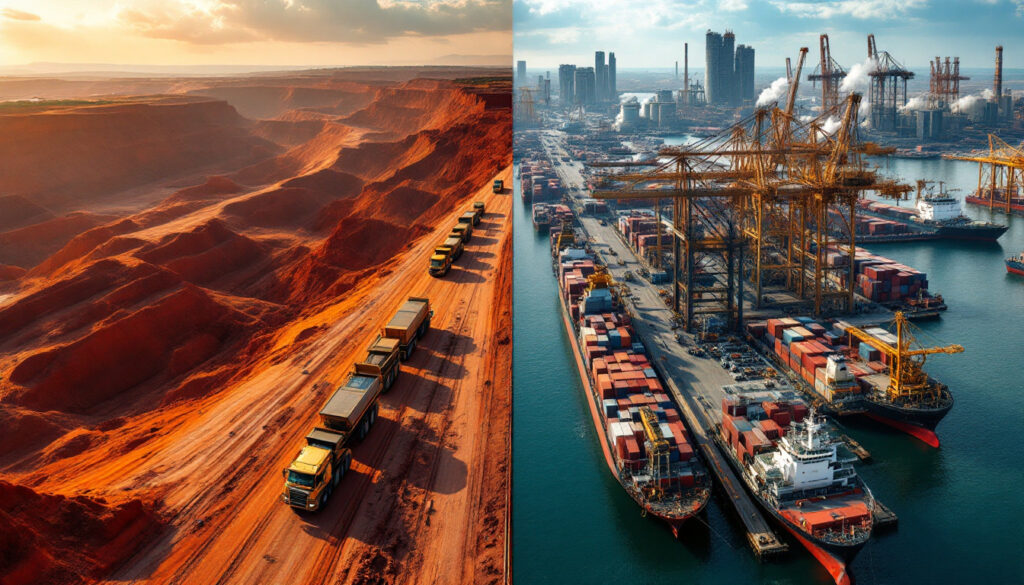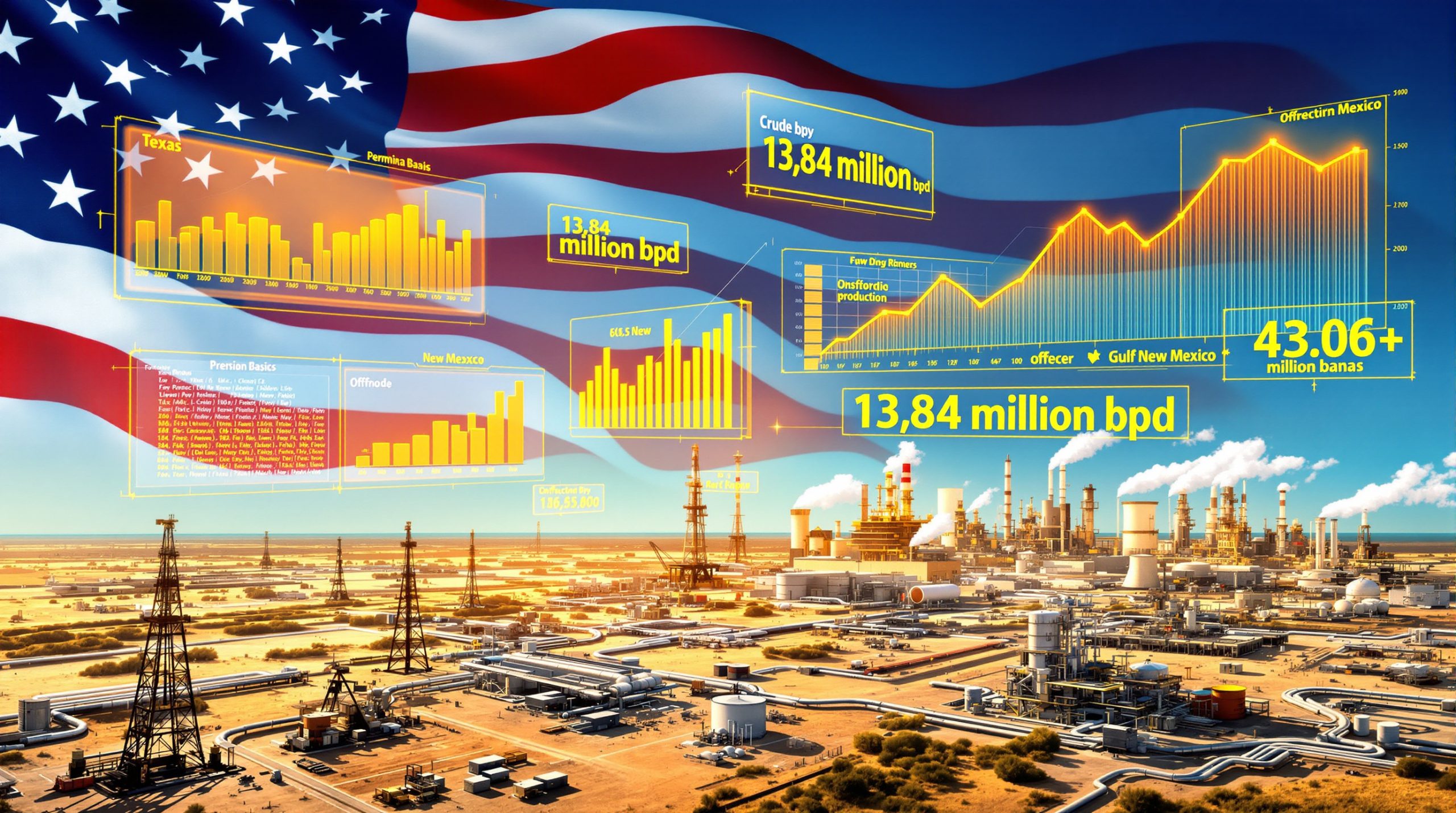How Is China's Iron Ore Market Responding to US Tariffs?
China's relationship with iron ore represents one of the most consequential commodity dependencies in the global economy. As trade tensions escalate between the United States and China, the iron ore and China tariffs offer a fascinating case study in economic resilience and vulnerability. This analysis explores how China's iron ore market is responding to US tariffs and what it reveals about broader economic patterns.
Understanding the Iron Ore-China Relationship
China's dominance in global iron ore markets cannot be overstated. The nation purchases over 70% of seaborne iron ore globally, transforming this raw material into more than half the world's steel supply. This positions iron ore as a critical lifeline for China's industrial economy and infrastructure development.
The relationship creates a unique market dynamic where iron ore price trends respond sensitively to China's economic policies, industrial output, and construction activity. Unlike many other commodities with diversified global buyers, iron ore's extreme exposure to a single dominant consumer creates both market vulnerability and strategic importance.
"Iron ore represents perhaps the purest exposure to China's industrial economy," notes Reuters columnist Clyde Russell. "Its price movements offer real-time insights into the health of China's manufacturing, construction, and infrastructure sectors."
This concentrated dependency means that iron ore prices serve as a leading indicator for China's economic health. When Beijing announces infrastructure stimulus, iron ore typically rallies. When property markets falter, prices retreat. This sensitivity makes iron ore futures particularly valuable for investors seeking to gauge China's true economic trajectory beyond official statistics.
What's Happening with Iron Ore Prices During the US-China Trade War?
Despite escalating tariff pressures, iron ore prices have demonstrated remarkable resilience. Singapore Exchange iron ore futures were trading at $99.35 per metric ton in May 2025, showing recovery from a seven-month low of $96.20 recorded on May 1, 2025. Since October 2024, prices have maintained a relatively stable range between $96.20 and $110.55, defying expectations of major volatility.
Several factors support this price stability:
-
Supply constraints from Australia: Cyclonic weather systems have disrupted shipments from major Australian mining regions, creating unexpected supply tightness that counterbalances demand concerns.
-
Declining port inventories: Chinese port stockpiles reached a 14-month low of 133.8 million tons by late April 2025, according to data from SteelHome, indicating that steel mills are drawing down existing supplies faster than they're being replenished.
-
Strategic stockpile management: Chinese steel producers have adopted careful inventory management strategies, balancing just-in-time purchasing with strategic stockpiling when prices dip.
This price resilience contradicts conventional wisdom that US-China trade war impact would severely depress industrial commodity markets. Iron ore's performance suggests that Beijing's domestic economic priorities continue to support baseline demand regardless of export sector challenges.
Are China's Iron Ore Imports Declining?
China's iron ore import data reveals nuanced trends beneath headline figures. First quarter 2025 imports totaled 285.31 million tons, representing a 7.8% year-over-year decrease. However, analysts attribute this decline primarily to supply disruptions rather than fundamental demand weakness.
Port inventory data supports this supply-side explanation. Stockpiles fell from 147.5 million tons in February to 133.8 million tons by April 2025, indicating robust consumption despite lower import volumes. This drawdown of existing supplies suggests steel mills are maintaining production levels by utilizing inventories when fresh shipments are delayed.
Signs of import recovery are emerging. Kpler tracking data shows April 2025 imports trending at approximately 101.4 million tons, which would represent an increase from March's 93.97 million tons. This aligns with seasonal patterns where Chinese buyers typically rebuild inventories heading into the summer construction season.
Most significantly, China's steel production data shows resilience rather than contraction. March 2025 output reached 92.84 million tons, a 4.6% increase year-over-year. This production strength challenges the narrative that tariffs impact on markets are severely impacting China's industrial heartland.
"The import numbers reflect supply-side constraints more than demand destruction," notes Russell. "When we examine steel production figures alongside inventory drawdowns, we see an economy that's consuming iron ore at rates inconsistent with significant industrial contraction."
Why Is Iron Ore Defying the "China Tariff Pain" Narrative?
Iron ore's resilience amid trade tensions reveals important structural features of China's steel demand. Approximately 60% of Chinese steel consumption flows to property and infrastructure sectors with minimal direct exposure to US markets. This domestic demand concentration provides a substantial buffer against export disruptions.
Recent government stimulus measures targeting property markets have stabilized a sector that had been struggling with developer debt issues. These interventions include:
- Reduced minimum down payments for home purchases
- Lower mortgage rates for first-time buyers
- Expedited infrastructure project approvals
The remaining 30% of steel consumption serves trade-exposed sectors like machinery, automotive manufacturing, and household appliances. However, even these sectors have significantly diversified export destinations beyond US markets:
- Southeast Asian nations absorb machinery exports
- European markets remain important for automotive components
- African infrastructure projects consume construction equipment
"The steel-intensive sectors most vulnerable to US tariffs represent less than one-third of China's total steel consumption, and even those sectors have diversified export markets well beyond America," notes industry analyst Yang Wei at China Metallurgical Industry Planning Institute.
This diversification strategy has been deliberate. Following earlier trade tensions in 2018-2019, Chinese manufacturers accelerated market diversification efforts, particularly through Belt and Road Initiative partnerships that opened alternative export channels for steel-intensive goods.
How Are China's Economic Indicators Reflecting Trade Tensions?
Mixed economic signals paint a complex picture of China's response to trade pressures. The manufacturing Purchasing Managers' Index (PMI) contracted to 49.0 in April 2025, down from 50.5 in March, marking the fastest contraction pace in 16 months. This reading below the 50-point threshold separating expansion from contraction suggests broader manufacturing weakness.
Yet steel production continues showing resilience despite this manufacturing PMI contraction. This divergence highlights the growing bifurcation in China's economy between:
- Export-oriented light manufacturing – facing headwinds from tariffs
- Domestic infrastructure and construction – supported by stimulus measures
Beijing has responded with targeted policy interventions. May 2025 brought interest rate cuts designed to reduce borrowing costs for businesses and consumers. The People's Bank of China also implemented liquidity-boosting measures including reduced reserve requirements for commercial banks.
These policies reflect a strategic pivot toward domestic consumption and investment as growth drivers. According to economist Li Chen at Peking University, "Beijing is implementing what we might call 'selective stimulus' – targeting sectors that can offset export weakness while avoiding broad-based stimulus that might reignite debt concerns."
The divergence between PMI contraction and steel production resilience reveals how policy responses are creating uneven impacts across economic sectors. This targeted approach allows Beijing to address specific vulnerabilities while maintaining overall economic stability.
What Does This Mean for Global Iron Ore Markets?
The divergent performance within China's economy creates complex implications for global iron ore markets. Export-oriented manufacturing sectors face clear headwinds, while infrastructure and domestic consumption demonstrate surprising resilience. This selective impact creates more nuanced market conditions than many analysts initially predicted.
Australia retains its position as China's primary iron ore supplier, providing approximately 65% of imports. Recent supply disruptions from cyclonic weather have highlighted the market's sensitivity to Australian production issues. As Mining.com reported in April 2025, "Cyclone damage to port facilities in Western Australia removed approximately 15 million tons of expected shipments from market projections for Q1 2025."
Major producers maintain strategic focus on preserving market share despite short-term disruptions. Rio Tinto, BHP, and Fortescue Metals Group continue investing in production efficiency and capacity expansion, signaling confidence in long-term demand despite current trade tensions.
Future market trends will likely follow seasonal patterns, with demand typically strengthening during summer construction months and weakening during winter. However, three key factors require monitoring:
- Infrastructure stimulus intensity – Beijing's willingness to accelerate project approvals to offset export weakness
- Property market stabilization – Whether recent supportive measures translate to sustained recovery
- Steel export redirection – China's success in opening new markets for steel-intensive exports
The iron ore market demonstrates that economic impacts from iron ore and China tariffs flow through complex channels rather than creating uniform effects across industrial commodities. As Reuters columnist Clyde Russell notes, "Iron ore tells a different story to the China tariff pain narrative – one where domestic priorities continue outweighing export disruptions for strategically important industries."
Expert Analysis: Two Competing Narratives
Two distinct narratives have emerged regarding China's economic response to US tariffs, with iron ore markets caught between competing interpretations:
The "Pain Narrative" Perspective
US administration officials emphasize evidence of economic damage, pointing to:
- Manufacturing PMI contraction as proof of tariff effectiveness
- Downward revisions to GDP growth forecasts from international organizations
- Reduced factory employment in export-oriented coastal provinces
This perspective suggests that sustained tariff pressure will eventually force deeper economic adjustments, with initial resilience giving way to more significant constraints as inventory buffers and policy responses reach their limits.
"The manufacturing PMI contraction represents the leading edge of broader economic impacts that will cascade through industrial supply chains," argues former US trade negotiator Robert Sullivan. "Initial resilience typically gives way to more substantial adjustments as businesses exhaust their ability to absorb margin compression."
The "Resilience Narrative" Perspective
Beijing's messaging emphasizes economic stability and adaptation, highlighting:
- Steel production growth despite manufacturing PMI contraction
- Successful export market diversification beyond US destinations
- Expanding domestic consumption offsetting export challenges
This narrative frames current challenges as manageable through targeted policy responses rather than representing systemic threats to economic stability. It suggests China's economy has developed sufficient complexity and domestic demand to weather external disruptions.
"Steel production figures reveal an economy far more resilient than headline PMI numbers suggest," notes economist Zhang Wei at China's State Information Center. "The divergence between these indicators reflects successful economic rebalancing toward domestic consumption and investment."
The iron ore market's performance lends credibility to elements of both narratives, revealing an economy experiencing sector-specific challenges rather than uniform contraction.
FAQ: Iron Ore and US-China Trade Tensions
How much of China's steel production is directly affected by US tariffs?
Less than one-third of China's steel consumption flows to potentially trade-exposed sectors like machinery, automotive production, and household appliances. Direct exports to the US represent an even smaller percentage, as China has diversified export destinations significantly since earlier trade tensions in 2018-2019.
Most steel consumption (approximately 60%) serves domestic construction, infrastructure, and property development with minimal direct exposure to international trade disputes. This insulates a substantial portion of demand from immediate tariff impacts.
Could iron ore prices collapse if trade tensions escalate further?
Historical precedent suggests a limited risk of price collapse. During previous periods of economic uncertainty, China typically increased domestic infrastructure spending to offset external weakness. The 2008-2009 global financial crisis and 2015-2016 domestic slowdown both saw Beijing deploy infrastructure stimulus that supported iron ore demand.
Current supply-side constraints, including Australian weather disruptions and relatively tight global production, provide additional price support. As port inventories have already declined to 14-month lows, significant additional downward pressure would likely trigger restocking rather than continued drawdowns.
Seasonal demand patterns remain influential regardless of trade tensions. Summer construction season typically drives increased consumption, while winter sees reduced activity due to weather constraints in northern China.
How are major iron ore producers responding to these market conditions?
Major producers maintain production targets despite short-term disruptions:
- Rio Tinto and BHP continue focusing on production efficiency improvements while monitoring Chinese policy responses
- Vale (Brazil) pursues gradual recovery of production capacity following earlier safety-related constraints
- Fortescue Metals Group advances higher-grade product development to meet evolving Chinese environmental standards
Producers view current trade tensions as creating less risk than earlier concerns about Chinese property market instability. Their strategic plans reflect confidence in long-term urbanization trends supporting baseline demand, regardless of near-term export sector challenges.
What indicators should investors watch to gauge future iron ore market health?
Four key indicators provide early signals of changing market conditions:
- Chinese property market statistics – New starts, completions, and sales volumes reveal real estate sector health
- Infrastructure spending announcements – Policy statements regarding project approvals and funding releases
- Port inventory levels and restocking patterns – Real-time measures of supply-demand balance
- Steel production utilization rates – Capacity utilization numbers reveal actual production intensity
These indicators collectively provide a more nuanced view than headline figures like GDP or manufacturing PMI, offering targeted insights into iron ore miners insights and demand drivers.
Investors should also monitor seasonal patterns, as summer typically brings increased construction activity and iron ore consumption, while winter sees reduced intensity, particularly in northern regions with harsher weather conditions.
As one market analyst noted, "Iron ore remains first and foremost a China story, with trade tensions representing just one factor within a complex domestic demand equation dominated by property, infrastructure, and industrialization." For a deeper understanding of future price movements, analysts are closely watching the iron ore price forecast for 2025 and beyond.
Want to Discover Major Mineral Finds Before the Market?
Stay ahead of significant ASX mineral discoveries with Discovery Alert's proprietary Discovery IQ model, which turns complex data into actionable investment insights. Visit our dedicated discoveries page to see how historic mineral finds have generated substantial returns for early investors.




